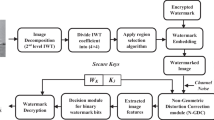Abstract
One of the open problems in lossless information hiding research is how to get adaptively better difference image architectures for given applications. In this paper we propose a simple and efficient approach to predict high-similar interpolation image from its sparse pattern and spectral expansion. After difference operator, peak value of the spike is very high. This method also provides a mathematic framework for evaluating de-correlating algorithm and can therefore be used to benchmark new algorithms. Finally, a proper reversible data hiding algorithm is also enclosed which refers conventional difference expansion principle. Overflow and underflow is considered in the fusion way. Simulations results demonstrate and verify that our new approach is much effective than local difference expansion method with good generalization performance.
Similar content being viewed by others
References
Tsai, P. (2009). Histogram-based reversible data hiding for vector quantisation-compressed images. IET Image Processing, 3(2), 100–114.
Honsinger, C. W., Jones, P., Rabbani, M., & Stoffel, J. C. (1999). Lossless recovery of an original image containing embedded data. U.S. Patent Application, 77102/E-D.
Tian, J. (2003). Reversible data embedding using a difference expansion. IEEE Transactions on Circuits and Systems for Video Technology, 13(8), 890–896.
Alattar, A. M. (2004). Reversible watermark using the difference expansion of a generalized integer transform. IEEE Transactions on Image Processing, 13(8), 1147–1156.
Ni, Z., Shi, Y. Q., Ansari, N., & Su, W. (2006). Reversible data hiding. IEEE Transactions on Circuits and Systems for Video Technology, 16(3), 354–362.
Thodi, D. M., & Rodriguez, J. J. (2007). Expansion embedding techniques for reversible watermarking. IEEE Transactions on Image Processing, 16(3), 721–730.
Tai, W. L., Yeh, C. M., & Chang, C. C. (2009). Reversible data hiding based on histogram modification of pixel differences. IEEE Transactions on Circuits and Systems for Video Technology, 19(6), 906–910.
Bruckstein, A. M., Donoho, D. L., & Elad, M. (2009). From sparse solutions of systems of equations to sparse modeling of signals and images. SIAM Review, 51(1), 34–81.
Miao, L. D., Qi, H. R., Ramanath, R., & Snyder, W. E. (2006). Binary Tree-based Generic Demosaicking Algorithm for Multispectral Filter Arrays. IEEE Transactions on Image Processing, 15(11), 3550–3558.
Lian, N. X., Chang, L., Tan, Y. P., & Zagorodnov, V. (2007). Adaptive filtering for color filter array demosaicking. IEEE Transactions on Image Processing, 16(10), 2515–2525.
Alleysson, D., Susstrunk, S., & Herault, J. (2005). Linear demosaicking inspired by human visual system. IEEE Transactions on Image Processing, 14(4), 439–449.
Author information
Authors and Affiliations
Corresponding author
Rights and permissions
About this article
Cite this article
Feng, G., Qian, Z. & Zhang, X. Spectrum-estimation based lossless information recovery for sparse array patterns. Telecommun Syst 49, 163–169 (2012). https://doi.org/10.1007/s11235-010-9365-4
Published:
Issue Date:
DOI: https://doi.org/10.1007/s11235-010-9365-4




